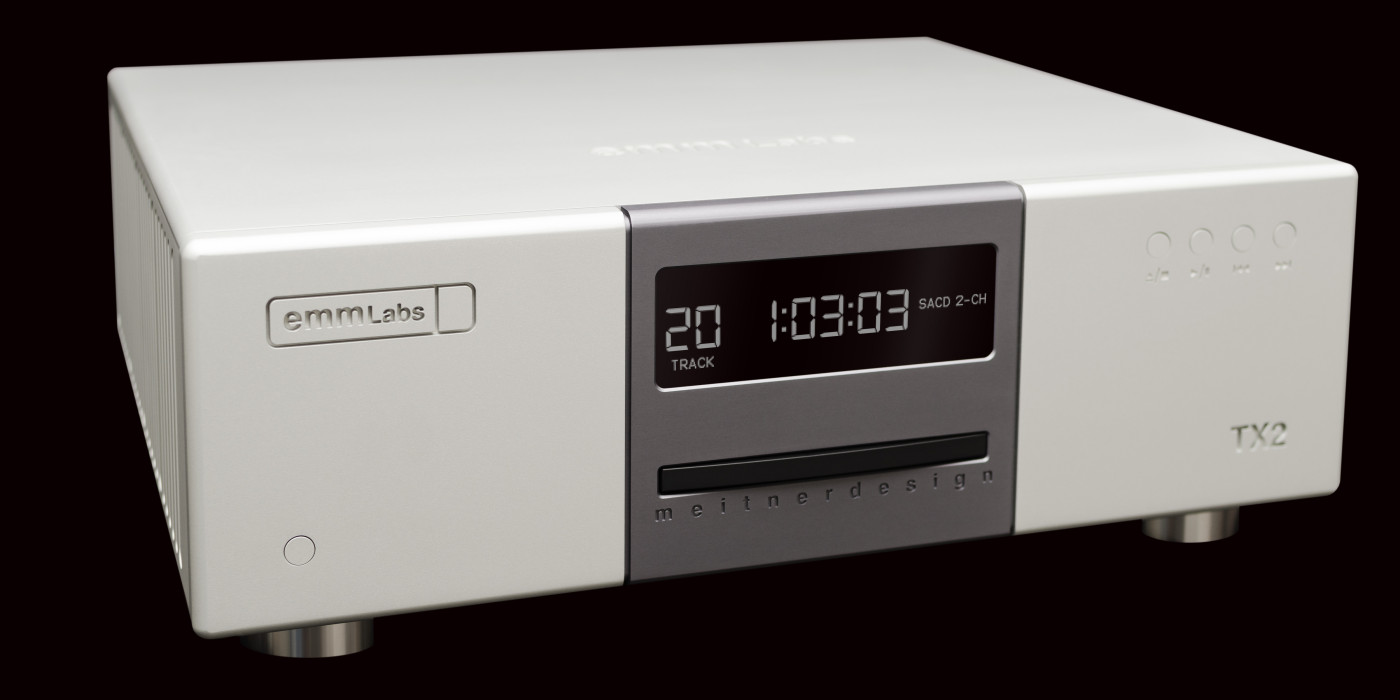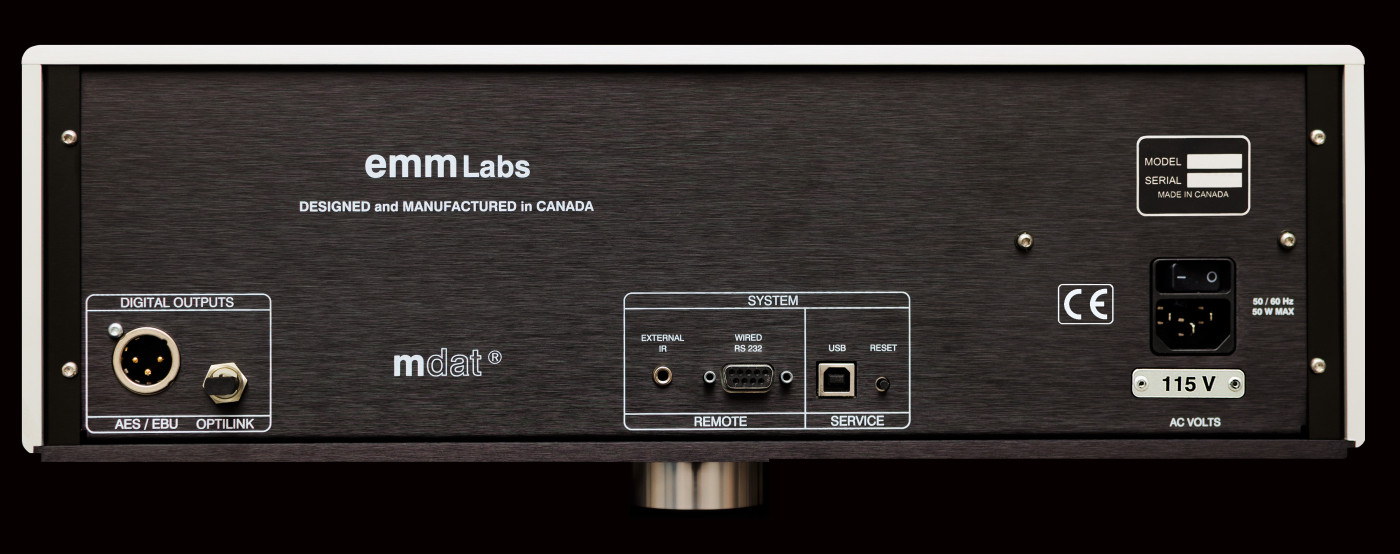Introduction
EMM Labs introduced a new stand-alone digital to analogue converter at CES, the DA2. Within days of the introduction, the first production run had been sold out and a second begun. Now the second run is also spoken for. As technology advances, there comes a point when the existing hardware platform will no longer support future changes. I believe that this was the point that EMM reached with respect to their current digital to analog converter and what precipitated the need for the DA2. In any event, given that I replaced an XDS1 (early version) with the Esoteric P-02/D-02, I thought that it would be very interesting to pit EMM Lab’s latest top of the line transport TX2 SAC and the DA2 against my reference and EMM Labs agreed to provide units for review.
Technology and Design
The story of the EMM Labs DA2 Reference DAC is essentially the story of its designer Ed Meitner. Everything Ed has learned in his long experience with electronics and audio has contributed to the DA2 design: from the chassis to the power-supplies, the digital audio interfacing, the digital audio signal processing, the digital-to-audio transition, and the analog output drivers.
The DA2 power supply is a power-factor-corrected switching design, the latest in a 20-year history of advanced Meitner switching power-supplies. It is efficient, universal, and non-polluting; wasting little energy while leaving little measurable footprint on the AC line and other devices nearby. It keeps the electrical environment inside the DA2 utterly stable and noise-free no matter what is going on outside of it.
The machined aluminum chassis is substantial but appropriate; it is as massive as necessary to protect the circuit boards inside from disturbances outside and not more. It is vibration-damped and incorporates a unique “charge management system” which stabilizes the electrical field surrounding its sensitive audio circuits. This idea of providing what is appropriate and necessary is a basic tenet for all of Ed’s designs, as is the corollary to use the “right” part, not necessarily the most expensive or exotic.
All DA2 digital audio inputs are galvanically isolated (including the USB Audio) and sensed by the patented MFAST high speed asynchronous data acquisition system. MFAST is more immune to source jitter than conventional PLL-based AES and SPDIF receiver chips. Even for this peripheral function of data input reception, Ed’s dedication to perfection shines through in the use of custom circuitry rather than off-the-shelf chips.
Once captured and decoded, the audio bit stream is processed by the MDAT2 firmware algorithms in an FPGA. Filtering and dithering is optimized and minimized, re-sampling is never done, while the MDAT2 architecture performs a more complete avoidance of digital artefacting than apodizing filters can ever hope to do. This is seen in the incredibly perfect square-wave and impulse playback with no pre-ringing or post-ringing (see attached picture) – musical transients thus remain more pure and un-smeared than by any other method. MDAT2 neither adds nor subtracts from the audio data and lets you hear precisely what was recorded and mastered. The FPGA firmware is, of course, upgradeable as future refinements are made.
The heart of the DA2 playback system beats on the ceramic-composite 6-layer analog audio board – the revamped MCLK master clocking system. MCLK has a temperature stabilized and electrically protected time-base with sub-picosecond jitter and is twice as fast as previous EMM systems – both in clock-rate and in responsiveness.
This precise and stable MCLK drives two of Ed’s latest and fastest MDAC digital-to-analog conversion modules. These natively-DSD inherently-precise digital-to-analog-converters are naturally free of differential nonlinearities found in all ladder, ring, or hybrid converters whether they are monolithic chips or discrete resistor designs. By design, each discrete MDAC is balanced and matched in itself and to others to within 0.2%.
Together, the minimalist and least-harm philosophy of the DA2’s MDAT2, MCLK and MDAC modules recreate two pristine channels of balanced audio for the Meitner output drivers. Each channel has twin plus and minus matched circuit paths which perform gentle, balanced, passive output filtering while using minimal feedback. Leading to robust and powerful class-A balanced line-buffers delivering purest audio no matter what they are connected into.
- (Page 1 of 2)
- Next page →



I have had my Da2 several months
Is wonderful from getting but improves even till now I went away for two weeks and couldn’t believe change
I think it is definitely better balanced though still very good Se
The bass is exceptional
But all timbres are great
I disagree about warmth I found it very track dependent
I agree about telling difference track to track
My soundstage is massive extending beyond speakers and frontal well as recording allows
Layering of string and instruments Suberb
Tonal space and recognition of instruments with similar timbres eg bass trombone compared with trombone best heard
It is sensitive to power cords finding Oyaide pc excellent results
I agree about vinyl versus the DA2 it’s getting very close especially on dsd2 and 176.4 and 356 recordings
I used with server with excellent results
I found the impedance of spdif quite critical to obtain worth
Excellent review
What firmware was your XDS1V2 running?
Congrats on your EMM Labs purchase! Have you had a chance to compare or hear the Playback Design DACs or the PS Audio with new firmware? Thanks!
The EMM XDS1 which I heard for comparison has the newest software, so I believe that the comparison was valid. I should also note that I have used the XDS1 as a transport for the DA2 and for those who already own an XDS1 that is an excellent, cost effective solution. I have spoken with Ed Meitner about “break-in”. He does not particularly like that term and feels that what is actually happening is that the boards and components within the unit are reaching “dielectric equilibrium” and that this takes about 250 hours. In any event, my DA2 has continued to improve, particularly with respect to dimensionality, resolution and dynamic range. The units as pointed out are sensitive to both vibration control and to power cords. I have had excellent luck with the Stage 3 power cords (Kraken) and with the Finite Elemente Cerabases.
I have not heard the latest Playback Design gear so cannot really comment on its sound, although the sound at shows using Playback Design gear is uniformly excellent. The same could also be said for the top of the line Esoteric gear (i.e. the sound at shows is excellent). I am always reluctant to make rankings of gear which I have not auditioned in my own home or in a system with which I am intimately familiar.
Hi Fred Crowder Thank you so much for the very fine review! I got my DA2 last Monday I am currently running it 24/7 Any suggestion how long I should run-in? I am thinking of some 500 hrs Will that y sufficient? Thanks
Strangely enough I asked Ed Meitner the same question. His response was 250 hours, although I am well beyond that and think that I am still hearing improvements. Ed corrected my terminology. He says that what is occurring is not so much break-in as the ceramic boards and parts reaching dielectric equilibrium. In any event, the phenomenon is audible. I hope that you enjoy your unit.
Thank you so much for the reply. Compare to my EMM Labs DAC2X, the resolution, dynamics and transparency are so much better. I am very happy with it. My sound system is now at the next level. I am currently using the Magico Q1 speakers together with the Magico Q 15 subwoofer, the EMM Labs Pre-2, Constellation Centaur power amp, Nordost Tyr II interconnect, shunyata anaconda speaker cables, Shunyata Sigma power cords, and Shunyata power conditioners. On very good recordings the acoustic instruments can sound very real. Once again thank you so much!
I My sound system now has very good dynamics, presence, and a tovery low noise floor. It sounds like a turntable. Once again, many thanks.
.
Hi I forgot to mention that I am using EMM Labs TSDX transport, playing only SACDs, mainly classical, some jazz, some folks. All my equipment are placed on Critical Mass System rack and amps stands. I also use Critical Mass System footers, and Soundtillpoints. I have to say that all the components are essential to the system low noise floor, dynamics, and presence. The CM rack and amp stand contribute greatly to it, also the Shunyata Sigma power cords.
Hi Fred,
Thanks for a great review. I took delivery of the TX2 and DA2 a few weeks ago – apart from the EMM optilink cable, have you tried connecting the two with AES/EBU? Thanks!
Tony
Hi, Tony,
I spoke at length with Ed Meitner about the optimal way to connect the TX2 and DA2 and he was adamant that there were significant sonic advantages in using the provided optical cable. This has something to do with ground loops/galvanic interactions which are eliminated with the optical. For this reason, I have not tried AES/EBU.
Sincerely,
Fred
Thanks Fred for your response. The reason I asked about the optical cable is related to it’s long term stability and variance in quality of optical cables. An audiophile friend who manufactures very sophisticated optical cables (according to him optical cables for hifi use is nothing sophisticated) has his engineers look at three different hifi optical cables (Aural Symphonic, Jadis and EMM Labs) with professional magnifying glass and found various levels of scratch and dirt. As optical cables use glass it is prone to scratch after pluging and unpluging, and of course dirt after long use. His engineers then cleaned all three cables (using whatever machines and methods unavailable to us). My friend then listened to all three cables, and found the Aural Symphonic to sound the best, and the EMM the worst. If this is indeed true, I wonder if we should try other optical cables, or use AES/EBU as backup to ensure no deterioration of the supplied EMM optical cable?
Hi all,
I am still new to the EMM Labs da2, I have read all your comments, can see this is a very good Dac unit.
I now have a Esoteric k-01 SACD player, thinking to upgrade to Esoterica K1, but now try to see/compare if I should keep the K-01 as a transporter and get a new EMM Labs da2 as a DAC. What you guys suggest what I should do?
Thanks.